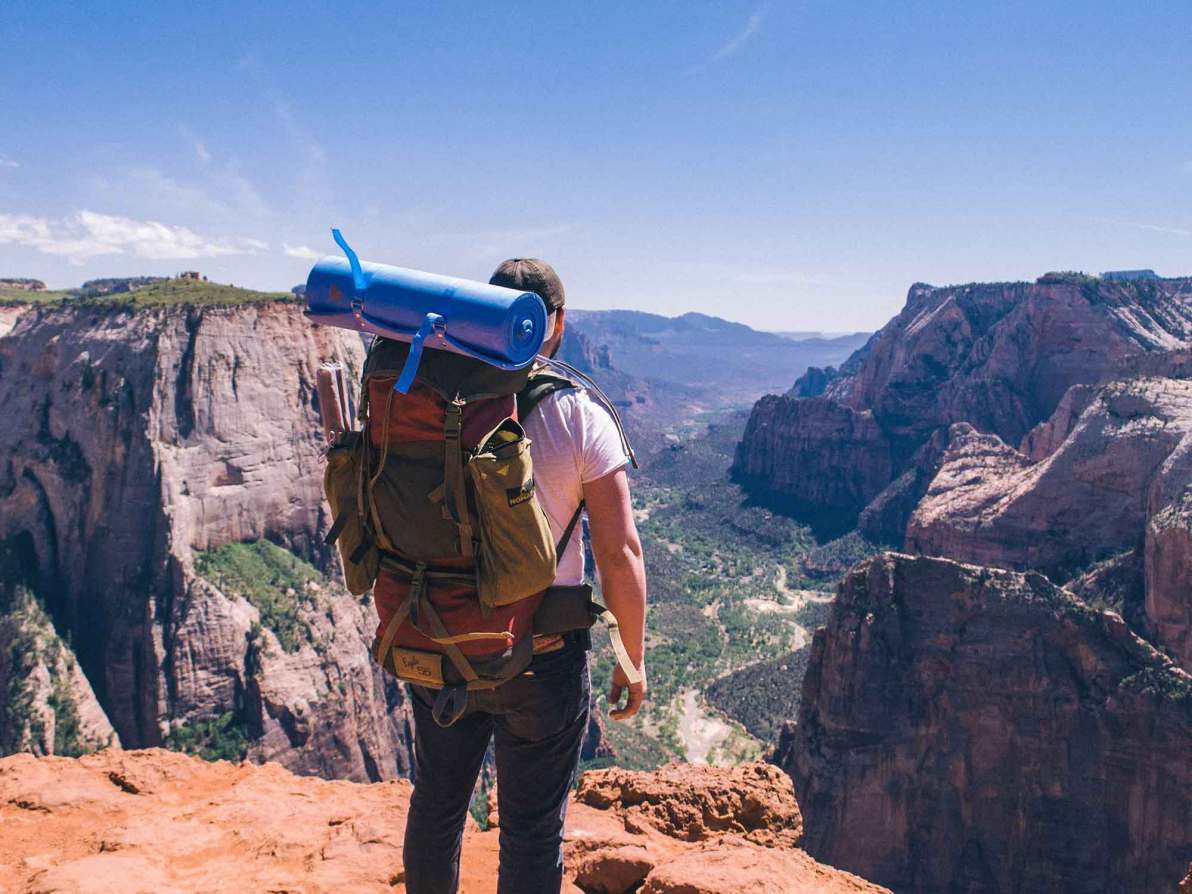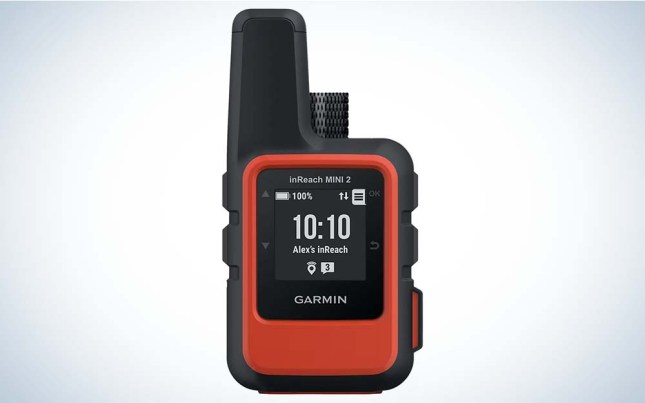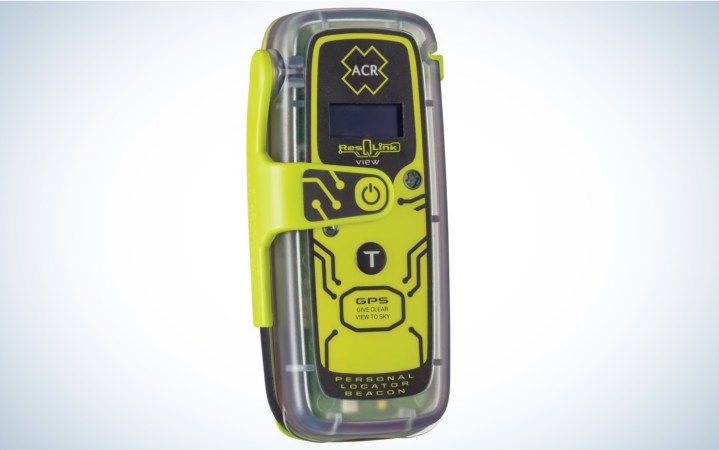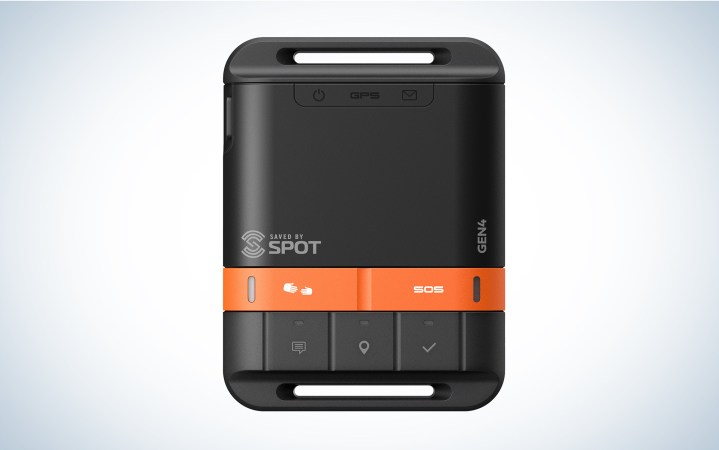We may earn revenue from the products available on this page and participate in affiliate programs. Learn More ›
If you spend significant time in the outdoors, then a personal locator beacon or satellite messenger should be in your pack. While these devices vary from single-use distress signals to full-blown phones that can be used in virtually any corner of the world, they all have the power to alert authorities when you are in trouble and—most importantly—share your GPS coordinates. While many individuals will find that they never need to use the SOS button, if you do need it, a PLB or sat device can save your life. Here are our picks for the best personal locator beacons and satellite messengers available today.
- Best Overall: Garmin inReach Mini 2
- Best GPS: Garmin inReach Explorer+
- Lowest Upfront Cost: ZOLEO
- Best for Long Trips: Garmin Messenger
- Best PLB: ACR ResQLink View
- Best Budget: SPOT Gen4

Our Experience with the Best PLBs and Satellite Messengers
I’ve hiked and backpacked for thousands of miles, and I frequently carry a satellite messenger with me, including models from Garmin, SPOT, and Somewear. While I’ve never had cause to hit the SOS button (knock on wood), in that time I have made use of the satellite messaging capabilities, and have gained a sense of their usefulness, and limitations. Recommendations in this story are based on my personal experience (as well as others on the OL team), the experiences of others using the Globalstar and Iridium networks, manufacturer specifications for each device (including weight, subscription costs, and battery life), and intended purpose.
Best Personal Locator Beacons and Satellite Messengers: Reviews & Recommendations
Best Overall: Garmin inReach Mini 2
Best Overall
Garmin inReach Mini 2
Key Features
- Weight: 3.5 ounces
- Satellite Network: Iridium
- Battery: Up to 14 days
Pros
- Has satellite messenger ability
- Pair with your phone using the Garmin Messenger app
Cons
- Breadcrumb map only
- Expensive
Tyler Freel took a look at the Garmin inReach Mini 2 and came back impressed with how the unit had improved over the original model. He noted that the inReach MINI 2 works best when paired with your smartphone via the Garmin Explore app, especially for more complete GPS functions and mapping, including the ability to download a variety of map layers including Topo North America, USGS Quad Sheets, and even aerial imagery for some areas. (He did find that the MINI 2 was easier to use without a mobile device than the MINI.)

One change with the MINI 2 is the addition of a “passive” trackback feature on the MINI 2, which allows you to backtrack along a track you’ve already made, even if you don’t currently have active tracking enabled. If you need to retrace your steps, you can recall them for up to 24 hours. Even better: to make location acquisition and satellite connection faster in remote places, the inReach MINI 2 connects to three different satellite networks in addition to GPS and Iridium communication satellites. You might not see a perceptible difference in connection times in some areas, but in steep mountain canyons, or other areas with limited direct visibility of the sky it can make a big difference. What the MINI 2 lacks is the option to have a basic topographic map on the unit, even with the small screen: you won’t have access to the full power and function of the MINI 2 without using it with a smartphone.
Best GPS: Garmin inReach Explorer+
Best GPS
Garmin inReach Explorer+
Key Features
- Weight: 7.5 ounces
- Satellite Network: Iridium
- Battery: Up to four days
Pros
- Has satellite messenger ability
- Pair with your phone using the Garmin Earthmate app
Cons
- Expensive
Garmin’s inReach Explorer set the standard for combining handheld GPS units with satellite messaging technology. It is without question the most popular GPS option for those who commonly hunt, fish, or travel in remote, rugged areas with little or no cell service. These Garmin GPS units (and all that utilize the inReach technology) work off of the Iridium satellite network to communicate via text message, retrieve detailed weather forecasts, and feature an SOS feature that summons rescue in case of emergency.
The original inReach Explorer is a fairly typical-sized handheld GPS with a screen that is smaller than many other units and no touchscreen. It does have an adequate display with a variety of map options, as well as a hunt-and-peck keyboard display for messaging, but is more user friendly when using with your smartphone via Bluetooth and the Garmin Earthmate app, which allows you to use essentially all of the unit’s functions through the convenience of your phone. —Tyler Freel
Best for Long Trips: Garmin Messenger
Best for Long Trips
Garmin Messenger
Key Features
- Weight: 4 ounces
- Satellite Network: Iridium
- Battery: Up to 28 days
Pros
- Long battery life
- Great paired messenger app
Cons
- Limited use of the two-way satellite messenger if your phone battery dies
One of the biggest reasons that people opt for Garmin inReach Mini 2 over the lower priced ZOLEO or Somewear devices is that you can still send out messages to your loved ones even if your phone becomes inoperable—say if the battery dies. The Garmin Messenger attempts to split the difference between these two options: it’s a chunk lower priced than the inReach Mini and while you can’t type out a message on the Garmin Messenger directly, you can read incoming ones, and you can send out pre-programmed messages to your contacts. (You can type out messages on the Messenger app on your phone, however.)
There are enough cool features with the Messenger app (most of which are now also available for other Garmin sat com devices) that you could almost overlook the real stand-out feature of the Garmin Messenger: its battery life. Whereas most of the best personal locator beacons and satellite messengers advertise a battery life of only a handful of days, the Garmin Messenger can last up to a month (two weeks if you expect the sky to be obstructed by canyons or canopy)—that’s twice the lifespan of the Garmin inReach Mini 2. So if you’ve been holding out on upgrading from your PLB (or are just tired of carrying around a spare battery pack for your sat com device), then this one is worth a serious look.
Lowest Upfront Cost: ZOLEO
Lowest Upfront Cost
ZOLEO
Key Features
- Weight: 5.3 ounces
- Satellite Network: Iridium
- Battery: Up to 8 days
Pros
- Easy setup
- Low upfront cost compared to other satellite messengers
- Easy check-in option to let your emergency contact know you are OK
Cons
- Inaccurate weather reports
- Highest per month fee (and a $4 fee per month to suspend service)
- Becomes a PLB if your smartphone battery dies
The ZOLEO is a great budget satellite communication device at $200 for the device and $20 a month for the basic service. You can send and receive messages on your phone through the device via email, text, or the ZOLEO app. I always use the app as it is the most user-friendly in my opinion letting you know if your messages are going through and providing an easy check-in option with your location coordinates. For a reasonable extra fee you can add location services to create waypoints along your route and freeze your service for three months. I appreciate the value and peace of mind of the ZOLEO but it certainly isn’t perfect. If you damage your phone or don’t have it, you won’t be able to send messages but you can send an emergency beacon or send a check-in with a pre-decided message from the device itself. The weather reports are also woefully inaccurate. —Ashley Thess
Best PLB: ACR ResQLink View
Best PLB
ACR ResQLink View
Key Features
- Weight: 5.3 ounces
- Satellite Network: COSPAS-SARSAT
- Battery: Up to five years
Pros
- One-time cost (no subscription required)
- 5-year battery life (assuming you leave it off)
Cons
- No satellite messaging capabilities
The ACR ResQLink View is as simple as personal locator beacons go. It’s only function is to send a distress signal—nothing else. The device uses GPS locating, 406 MHz, and 121.5 MHz homing capability to send an SOS, meaning the authorities can find you anywhere in the world, including on the vastest of oceans. The device does not require a subscription, but only works for 5 years, which is the length of the device’s battery life. Several other features make it especially marine-worthy: The beacon is buoyant. It has an LED strobe and an infrared strobe. A multi-function clip allows you to keep the beacon close by at all times.
Best Budget: SPOT Gen4
Best Budget
SPOT Gen4
Key Features
- Weight: 5 ounces
- Satellite network: GlobalStar
- Battery: 4 AAA lithium
Pros
- More affordable than other satellite messengers
- Lightweight
Cons
- Lacks two-way communication
- Works off of the GlobalStar network
The SPOT was the first personal locator beacon with satellite messenger I ever owned, and like a lot of backcountry adventurers, I mainly got it to let my mom know I was OK. That’s because while the SPOT does not allow for two-way satellite communication, it’s more than just a personal locator beacon: you can pre-record a couple of messages and send those out (along with your GPS coordinates) without triggering a whole search-and-rescue operation. In essence, it’s a satellite GPS tracker. As near as I can tell there are only two obvious functions for this: 1) to let people in the frontcountry know that you are OK (useful for longer trips) and 2) to request pickup from your emergency contact in the event that you run out of food along a remote forest service road but don’t need to be rescued immediately per se.
The SPOT does a pretty good job at this: while I used it, it managed a 95 percent success rate in sending out my daily check-ins. (You can guess what happened to my mom the other 5 percent of the time—we eventually started checking in twice a day.) My sense is that this was less an issue with the SPOT device itself, but rather that the GlobalStar network lacked coverage for especially tough to reach spots, such as canyons. (Since I originally tested the device, GlobalStar has added more satellites to their network, although they still have fewer than the Iridium network).
Read Next: The Best 2 Way Radios of 2023
What to Consider Before Buying a Personal Locator Beacon or Satellite Messenger
Personal Locator Beacon versus Satellite Messenger
While “personal locator beacon” and “satellite messenger” are terms that are often used interchangeably, there are important differences between these two products.
A personal locator beacon has one function, and one function only: to send an SOS signal via satellite, alerting the nearest search-and-rescue team or land agency that you are in need of assistance. There is no way to communicate with the SAR team, or even check that your SOS signal has been received. On the plus side, PLBs typically only require an upfront cost to function, reducing your overall costs.
Waiting for a satellite to come into view so that you can send or receive messages to loved ones can sometimes take a while.
A satellite messenger allows you to communicate with individuals in the frontcountry directly. These devices require an active subscription to work, billed as either a monthly or yearly cost. In addition to a separate SOS function, satellite messengers allow you to text directly with a contact in the frontcountry, which can be useful for learning about updates to conditions, coordinating pickup, or even just reassuring a loved one that you are safe. Some, but not all, satellite messengers come with a built-in keyboard, while others allow you to use your smartphone to interface.
Satellite Network
Instead of cellphone towers, personal locator beacons and satellite messengers communicate with satellites that are orbiting the earth. If you’ve ever noticed that it takes a while for your message to go out, that’s because your device is waiting for a satellite to come back into range. The reason for this gap is that it’s very expensive to send satellites up into orbit. So it’s no surprise here that the most trusted emergency satellite network is Cospas-Sarsat, a nonprofit collective of over 40 countries, composed of five low-earth orbiting (LEO) satellites, seven geostationary orbiting (GEO) satellites, and 35 medium-altitude-earth orbiting (MEO) satellites.
Part of why Cospas-Sarsat is considered the most reliable is that it’s simply been tested more than any other—the first rescue on the network occurred in 1982. But there is a downside: Because it is a nonprofit cooperative, Cospas-Sarsat only supports emergency communications. So there is no way to arrange a pickup, confirm a rendezvous, or even just ping loved ones to let them know you are OK.
To fill that gap, a number of privately owned networks have sprung up to support two-way messaging through their own system of satellites. Of these, the two that have emerged as the leaders in backcountry communication are Globalstar (which has 48 satellites) and Iridium (75).
Weight
When you’re going into remote areas, odds are that you will want to make every ounce count, and that includes your personal locator beacon or satellite messenger. All PLBs are designed to be able to be carried on your person. They should never be so large that you hesitate attaching one directly to yourself or your backpack. That said, there is still a range of sizes available in today’s PLBs. The smallest devices come in it at around 3 ounces, while larger devices can weigh upwards of 7 ounces. Lightweight devices may have less features than larger, bulkier ones, but what you sacrifice in functionality you gain in portability.
FAQs
Whether or not you need a personal locator beacon depends on how much time you spend exploring the backcountry, especially places you aren’t familiar with and where other people aren’t close by. If you spend a lot of time exploring remote areas, you should purchase a PLB.
The most affordable PLBs are between $150 and $200. The standard PLB is around $300, while the top-rate PLBs are upwards of $400.
While you do not need a subscription to use a personal locator beacon, you do need a subscription to use satellite communication devices. Subscriptions typically vary between ten dollars per month (allowing only a limited number of text messages, up to sixty-five dollars per month, for unlimited text messages.
Personal locator beacons typically come with built-in batteries that last for five years. Satellite messengers also come with built-in batteries, which can (and should) be recharged before the start of each trip.
Personal locator beacons do not come with text messaging functionality, but most (although not all) satellite messengers do. Be sure to check the subscription plan of your satellite messenger to see how many text messages you are allowed to send per month.

Why Trust Outdoor Life?
Since 1898, OL has been a leading authority in testing and reviewing hunting gear, fishing tackle, guns and shooting equipment, and much more. We have more than a century-long history of evaluating products, and we’re now bringing that expertise to online reviews. Our editors are experienced outdoorsmen and women, and most importantly, we’re trained journalists. We prioritize field testing and objective data when reviewing products. We conduct interviews with gear manufacturers and engineers as well as outdoor experts so that our readers have an understanding of how and why a product works—or doesn’t.
Advertising does not influence our gear reviews and it never will. While we always focus our coverage on standout products—because we want our readers to be aware of the latest and greatest gear—we also cover the flaws and quirks of any given product.
Final Thoughts
A personal locator beacon is a must-have safety device for any hunter, backpacker, angler, or adventurer who spends significant time in the backcountry. Make them a part of your standard survival kit, an emergency radio and one of the best emergency blankets. While there is increasing cell coverage in the backcountry (including through satellite networks, like Starlink), the tried and true SOS capabilities of the Iridium and Globalstar networks make one of these devices a must-have for the backcountry. While most individuals—whether you are out for the day or for the week—will benefit most from the lightweight Garmin Inreach Mini, consider the cost, weight, and functionality of your satellite messenger before making a final purchase decision.









